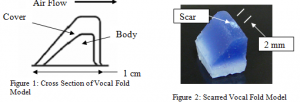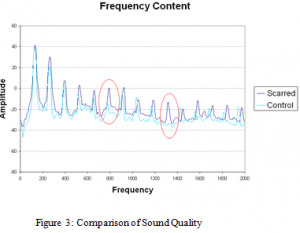Todd Groesbeck and Dr. Scott Thomson, Mechanical Engineering
Introduction
The influence of scarring on the vocal folds is of great interest to the speech community. Surgeons, educators, and vocalists all have interest in understanding what causes vocal fold damage, and how such damage may be repaired. Frequently, repair requires surgery, and the surgery may result in scarring. Scarring results in impaired vibration, thus altering the quality of the individual’s voice.
Synthetic representations of the vocal folds are useful in studying vocal fold vibration. They are long-lasting, the stiffness of different layers of the human vocal fold may be properly imitated, and no animals are needed for study.
Methodology
A synthetic two-layer model of the human larynx was constructed to mimic the mechanical properties of a healthy voice (cross-section illustrated in Fig. 1). A second synthetic model containing a scar was fabricated (Fig. 2). The scar had the same stiffness as the body, was approximately cylindrical in shape, and was 2 mm long. The stiffness of the body and scar was approximately 3 times that of the cover (Young’s modulus 10 and 3 kPa, respectively).

The following variables were measured: onset pressure, flow rate, acoustics (frequency spectrum), and the position of points on the surface during vibration (using direct linear transformation). These variables allowed us to compare the unscarred (control) model to the scarred model. Onset pressure is a measure of the amount of pressure required to initiate vibration. It provides some idea of the amount of difficulty a human would have speaking if they actually had this model as their vocal folds. Acoustics help define characteristics of the vocal fold model. The position of points on the surface during vibration helps us to visually track the displacement of the vocal fold model as it vibrates. A scar is expected to alter this movement.
Results and Discussion of Results
The onset pressure and the flow rate were both slightly greater for the scarred model (Table 1). This suggests potential increased difficulty for a human to use a damaged vocal fold. The fundamental frequency, however, was not changed by the scar. This was expected since the scar was a relatively small change in overall geometry.
![]()
Figure 3 shows how the sound amplitude changes with frequency. The relative amplitude of the peaks in the figure correspond to the nature of the sound produced. The data shows some differences between the two models. Notice that scarred (dark blue) does not contain two of the spikes that control does (light blue), and that the peaks do not completely coincide.

The displacement tracking indicated that the scarred model displacement was approximately 1.2 times that of the unscarred model.
Conclusion

In summary, two synthetic vocal fold models were made; one represented a healthy vocal fold while the other contained a scar. Testing indicated that scarring does influence vocal fold vibration and that it may be more difficult for a human to use a scarred vocal fold. In addition, the sound quality of the scarred vocal fold was altered. It is recommended that further research be done on more than one pair of control/scarred models in order to verify these results.
